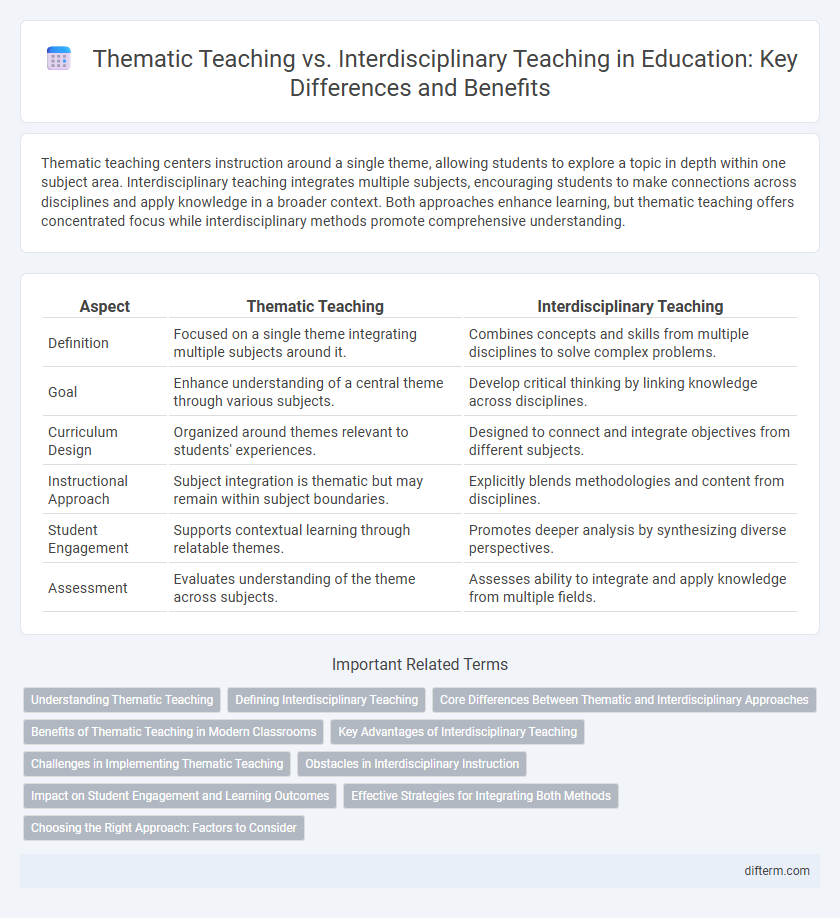Thematic teaching centers instruction around a single theme, allowing students to explore a topic in depth within one subject area. Interdisciplinary teaching integrates multiple subjects, encouraging students to make connections across disciplines and apply knowledge in a broader context. Both approaches enhance learning, but thematic teaching offers concentrated focus while interdisciplinary methods promote comprehensive understanding.
Table of Comparison
| Aspect | Thematic Teaching | Interdisciplinary Teaching |
|---|---|---|
| Definition | Focused on a single theme integrating multiple subjects around it. | Combines concepts and skills from multiple disciplines to solve complex problems. |
| Goal | Enhance understanding of a central theme through various subjects. | Develop critical thinking by linking knowledge across disciplines. |
| Curriculum Design | Organized around themes relevant to students' experiences. | Designed to connect and integrate objectives from different subjects. |
| Instructional Approach | Subject integration is thematic but may remain within subject boundaries. | Explicitly blends methodologies and content from disciplines. |
| Student Engagement | Supports contextual learning through relatable themes. | Promotes deeper analysis by synthesizing diverse perspectives. |
| Assessment | Evaluates understanding of the theme across subjects. | Assesses ability to integrate and apply knowledge from multiple fields. |
Understanding Thematic Teaching
Thematic teaching organizes curriculum around central themes that connect various subjects, enhancing students' ability to see relationships and deepen understanding within a specific topic. This approach fosters engagement by allowing learners to explore content through a cohesive lens, making abstract concepts more relevant and accessible. Emphasizing thematic units encourages critical thinking and retention by integrating knowledge in a meaningful, context-driven manner.
Defining Interdisciplinary Teaching
Interdisciplinary teaching integrates multiple subjects to create a cohesive learning experience that mirrors real-world complexities and promotes critical thinking. Unlike thematic teaching, which centers lessons around a common theme, interdisciplinary teaching blends skills and knowledge from various disciplines to solve problems and explore topics in depth. This approach enhances students' ability to make connections, increase engagement, and apply learning across contexts.
Core Differences Between Thematic and Interdisciplinary Approaches
Thematic teaching centers on exploring a single topic or theme across various subjects, promoting depth and context within that specific theme. Interdisciplinary teaching integrates multiple disciplines to address complex questions or problems, fostering critical thinking and connections between subject areas. Core differences include thematic teaching's focus on student engagement through a unified theme, while interdisciplinary teaching emphasizes synthesis and application of knowledge from diverse fields.
Benefits of Thematic Teaching in Modern Classrooms
Thematic teaching enhances student engagement by connecting lessons to real-world themes, promoting deeper understanding and retention. It fosters critical thinking and collaboration through integrated subject matter, making learning more meaningful and relevant. Modern classrooms benefit from thematic teaching by accommodating diverse learning styles and facilitating a holistic educational experience.
Key Advantages of Interdisciplinary Teaching
Interdisciplinary teaching fosters critical thinking by integrating multiple subject areas, enabling students to make connections across disciplines and apply knowledge in real-world contexts. It enhances problem-solving skills through collaborative learning experiences and exposes students to diverse perspectives, promoting deeper understanding and innovation. This approach also prepares learners for complex challenges by developing adaptability and comprehensive analysis capabilities essential in modern education and careers.
Challenges in Implementing Thematic Teaching
Thematic teaching faces challenges such as aligning curriculum standards with diverse thematic units and managing time constraints for thorough exploration of topics. Teachers often require extensive training to design and integrate themes effectively while addressing varying student interests and learning styles. Limited resources and assessment difficulties further complicate the consistent implementation of thematic teaching in educational settings.
Obstacles in Interdisciplinary Instruction
Interdisciplinary teaching faces significant obstacles such as rigid curriculum structures that limit integration across subjects and a lack of professional development for educators to effectively collaborate and design cohesive lessons. The challenge of aligning diverse assessment standards and balancing depth with breadth in content coverage often hinders comprehensive interdisciplinary instruction. Insufficient administrative support and resource allocation further complicate the implementation of interdisciplinary approaches compared to thematic teaching, which typically remains confined within a single subject area.
Impact on Student Engagement and Learning Outcomes
Thematic teaching enhances student engagement by organizing content around a central topic, allowing students to deepen their understanding through related materials and activities, which fosters retention and critical thinking. Interdisciplinary teaching integrates concepts from multiple subjects, promoting higher-order thinking and real-world problem-solving skills by encouraging students to make connections across disciplines. Both approaches improve learning outcomes, yet interdisciplinary methods often produce stronger results in collaborative skills and adaptability, essential for 21st-century education.
Effective Strategies for Integrating Both Methods
Thematic teaching centers on exploring a topic through a single subject's lens, while interdisciplinary teaching merges concepts from multiple disciplines to create holistic learning experiences. Effective strategies for integrating both methods include designing units that align core themes with relevant cross-curricular connections, using project-based learning to foster critical thinking and collaboration. Incorporating technology tools and continuous formative assessments ensures that students engage deeply with content from multiple perspectives while reinforcing thematic understanding.
Choosing the Right Approach: Factors to Consider
Choosing the right approach between thematic teaching and interdisciplinary teaching depends on curriculum goals, student needs, and subject integration complexity. Thematic teaching focuses on a central theme to enhance coherence within a single subject context, while interdisciplinary teaching bridges multiple disciplines to foster critical thinking and real-world problem-solving skills. Analyzing factors such as lesson objectives, resource availability, and assessment methods ensures an effective educational strategy tailored to diverse learning environments.
Thematic teaching vs interdisciplinary teaching Infographic

 difterm.com
difterm.com